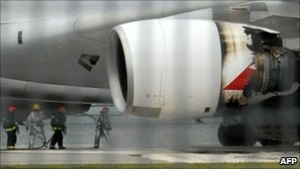Rolls-Royce ‘regrets’ Qantas Trent 900 blow-out

Rolls-Royce has offered its support the conclusions of the Australian Transport Safety Bureau report into the failure of a Trent 900 engine on board a Qantas Airways Airbus A380 on November 4th, 2010.
Colin Smith, director engineering & technology, Rolls-Royce, said: “This was a serious and rare event which we very much regret.
“At Rolls-Royce we continually strive to meet the high standards of safety, quality and reliability that our customers and their passengers are entitled to expect.
“On this occasion we clearly fell short.
“The robustness of the Airbus A380 and the professionalism of the Qantas crew members assured that the aircraft and all its passengers landed safely.”
Earlier today, the ATSB published its final report into the incident, which happened on a flight from Singapore to Sydney.
The incident was caused by a leak from an oil pipe on one of the aircraft’s four engines.
The oil pipe was one of a small number which had been incorrectly manufactured as a result of a measurement error during a precision drilling procedure.
The oil leak led to a fire in the engine and the break-up of a turbine disc, fragments of which exited the engine and caused significant damage to the aircraft. This is described in the industry as an uncontained disc failure.
The aircraft returned to Singapore and landed safely.
“We support the ATSB’s conclusions and, as the report notes, have already applied the lessons learned throughout our engineering, manufacturing and quality assurance procedures to prevent this type of event from happening again.”
Following the incident, and in parallel with the ATSB’s investigation, Rolls-Royce carried out its own detailed investigations to understand and address the chain of events which led to faulty oil pipes being released into service.
A number of issues were identified and changes implemented to address them, including:
- Modification of the engine software to prevent a turbine disc from bursting as a result of over-speeding following a similar failure.
- Better quality assurance processes with supporting training.
- Revised analysis of the likely effects on an engine in the event of a component failure.
- Improved manufacturing and design procedures.
Uncontained disc failures are extremely uncommon.
Before November 4th 2010, the last such failure on a Rolls-Royce large civil engine occurred in 1994 since when the fleet has accumulated more than 170 million engine flying hours.

